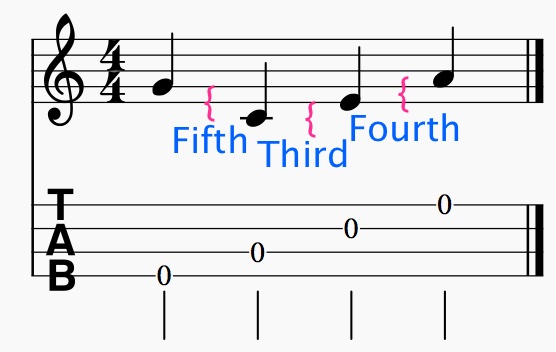tuning
Tuning means to calibrate an instrument relative to a normalized frequency (usually concert pitch a'1)). With a stringed instrument, pure tuning is possible, i.e., the distances between the pitches of the individual strings correspond to exact intervals (in the case of the ukulele: minor thirds, as in c'–e'–g' or fourths: g'–c', e'–a'; see also chord).
A tuning in which a simple chord sounds when all strings are played open (without being plucked) is called an open tuning. All common tunings for the ukulele are open tunings. They are each named after the open chords that can be played with them. C6 and D6 tuning go back to the early days of the ukulele. C6 tuning prevails in the U.S. and Japan, while Europe and Canada have long been dominated by the D6 tuning. A common jingle for reentrant tunings is My Dog Has Fleas.
Open Chords on the Ukulele
When the strings of an ukulele are plucked from the 4th to the 1st string in open root position (all strings are open = no fret is pushed), the following notes are played (red = reentrant, blue = linear tuning):
G-C-E-A
A-D-F#-B
Bb-Eb-G-C
D-G-B-E
Thus, the open chord of an ukulele forms a third-fourth-chord (= Major Chord) with added sixth (and are therefore called, according to the tuning, C6, D6, Eb6 or G66; see fifth-sixth-chord).
Eb6
BEbGC (Jazz)
In combination with Jazz instruments, a tuning that was still half a tone higher, thus in Eb6, was also common.

Accordatura, Scordatura, Open Tuning
The common (standard) tuning of an ukulele is called accordatura. A tune deviating from the accordatura, for which one or more strings of the ukulele have to be retuned, is called the scordatura. If you tune the first string one tone lower than usual (in C6: A→G, in D6: B→A), you get an open tuning: When you play the empty strings you already get a major chord (C major or D major). If you tune the fourth string one tone higher, you get another open tuning: The open strings play a minor chord (A minor or B minor).
Tuning by Harmony
Regardless of the tuning, checking whether all strings on an ukulele are in tune is easy. This kind of tuning is called tuning by harmony.
First, the first string is tuned open. In C6 tuning this can be used a tuning fork. The first string may not be detuned thereafter.
Reentrant tuning
The pitch in the 5th fret of the second string must match the open first string. The 4th tone of the 3rd string is then adapted to the pitch of the open second string. The tone in the 2nd fret of the fourth string must match the pitch of the open first string. <class chords> xx50. x40.x 2xx0.</class>
Linear tuning
The pitch in the 5th fret of the second string must match the open first string. The 4th tone of the 3rd string is then adapted to the pitch of the open second string. Finally, the pitch of the 5th fret of the fourth string is adapted to the pitch of the open third string. <class chords>xx50. x40.x 50.xx</class>
Links
Tuning onlineReferences
- Richter, Axel: Ukulele Handbook For Soprano, Concert, Tenor, and Baritone Uke. Pacific: Mel Bay. 2004 (Enthält die wichtigsten Akkorde in jeder Stimmung)











